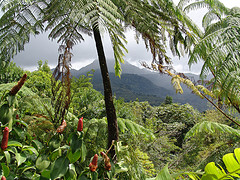|
NEWS
Seeking new wet carbon project proposals
 Working in partnership, Danone, IUCN and Ramsar are seeking new wet carbon project proposals, particularly large scale mangrove restoration proposals, which will deliver certified carbon credits as well as community benefits. More information including guidance on submitting a Project Idea Note (PIN) can be found at:
http://wetcarbon.com.
Working in partnership, Danone, IUCN and Ramsar are seeking new wet carbon project proposals, particularly large scale mangrove restoration proposals, which will deliver certified carbon credits as well as community benefits. More information including guidance on submitting a Project Idea Note (PIN) can be found at:
http://wetcarbon.com.
GEF Science Panel workshop on carbon benefit
 On 1-2 September, the Global Environment Facility (GEF) Science Panel convened a workshop in Washington, D.C. on "Approaches to Address Carbon Benefit in the context of Multiple Global Environmental Benefits in Implementing the SFM/ REDD+ Program in GEF-5". The objectives were: 1) to assess how to enhance the delivery of multiple global environment benefits (GEBs) and social benefits in the SFM/REDD+ program of the GEF; and 2) to identify a list of advisory products that will contribute to a toolkit for the GEF's SFM/REDD+ program. More: http://www.unep.org/stap/Events/SciencePanelWorkshops/CarbonBenefitsofSFMREDD/tabid/4914/Default.aspx. On 1-2 September, the Global Environment Facility (GEF) Science Panel convened a workshop in Washington, D.C. on "Approaches to Address Carbon Benefit in the context of Multiple Global Environmental Benefits in Implementing the SFM/ REDD+ Program in GEF-5". The objectives were: 1) to assess how to enhance the delivery of multiple global environment benefits (GEBs) and social benefits in the SFM/REDD+ program of the GEF; and 2) to identify a list of advisory products that will contribute to a toolkit for the GEF's SFM/REDD+ program. More: http://www.unep.org/stap/Events/SciencePanelWorkshops/CarbonBenefitsofSFMREDD/tabid/4914/Default.aspx.
Online interactive course on REDD+
The Nature Conservancy, Conservation International, the Climate, Community, and Biodiversity Alliance,
the Rainforest Alliance, the World Wildlife Fund, and GTZ have updated their online introductory course on reducing emissions from deforestation and degradation and conservation and enhancement of forest carbon stocks (REDD+) with new information and activities. The course is free and publicly available at: http://www.conservationtraining.org/.
 News, opinions and analysis on REDD and biodiversity
News, opinions and analysis on REDD and biodiversity
For the latest news, opinions and analysis on REDD and biodiversity in the developing world visit SciDev.Net. This includes news on Nepal selling its carbon stocks, the threat of forest fires in the Brazilian rainforests on emission reductions, the creation of protected areas to reduce poverty and biodiversity conservation interventions that can lift communities out of poverty.
For all these stories and more, visit: http://www.scidev.net/en/agriculture-and-environment/forestry/news/.
Prototype governance assessment tool
CIFOR researchers have produced a prototype, governance assessment tool, for use at local levels (communities, districts, landscapes). A three to five member, interdisciplinary (multi-stakeholder, dual gender) team spends 1-2 weeks in the field, assessing the tool's 12 indicators of good governance. The tool has three sections: stakeholders and their relationships, access to resources, and structure and function of governance. It is intended to reflect the views of all stakeholders, including marginalized groups (e.g., women, hunters and gatherers, minority ethnic groups). Although the tool could be used as a scorecard, the most appropriate use is for identification of areas of comparative strength and weakness (so as to build collaboratively on strengths and address weaknesses). It is available in Colfer and Pfund's book,
Collaborative Governance of Tropical Landscapes (Earthscan, London, in press, available at: http://www.earthscan-usa.com/Books/BookDetail.aspx?productID=271718).
|
|
PUBLICATIONS
REDD: A casebook of on-the-ground experience
 The Nature Conservancy, Conservation International, and the Wildlife Conservation Society have altogether implemented 34 pilot projects related to forest carbon, 17 of which are REDD specific. This casebook shares lessons learned from these experiences and closely profiles four REDD pilot projects to offer important insights for ongoing and future forest carbon projects. Available at:
http://www.hedon.info/docs/REDD_Casebook-TNC-CI-WCS.pdf.
The Nature Conservancy, Conservation International, and the Wildlife Conservation Society have altogether implemented 34 pilot projects related to forest carbon, 17 of which are REDD specific. This casebook shares lessons learned from these experiences and closely profiles four REDD pilot projects to offer important insights for ongoing and future forest carbon projects. Available at:
http://www.hedon.info/docs/REDD_Casebook-TNC-CI-WCS.pdf.
New book on Forest Biodiversity Monitoring
The monitoring of REDD biodiversity benefits is currently being discussed in many fora. In this context, "Monitoring Forest Biodiversity" (by Toby Gardner), published by Earthscan in its Forest Library series, provides useful suggestions for improvements in analysis and interpretation of forest biodiversity data, and outlines cost-effective monitoring options. More: http://www.earthscan.co.uk/Books/Series/TheEarthscanForestLibrary/tabid/51887/Default.aspx.
| Click here for more information on REDD-plus |
|

How can you publish in this Newsletter?
Your contributions to this Newsletter on issues related to biodiversity
aspects of REDD-plus are welcome. Please send your submission to [email protected]. Articles should contain no more
than 60 words, and must contain a hyperlink for more information. For more information please see:
http://www.cbd.int/forest/redd/newsletters/
Deadline to submit articles for the next issue: 1 November 2010.
This Newsletter is published pursuant to CBD decision IX/5. The views expressed in this publication do not necessarily reflect the views of the Secretariat of the CBD.
|


 News, opinions and analysis on REDD and biodiversity
News, opinions and analysis on REDD and biodiversity